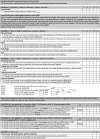Development of the first disability index for inflammatory bowel disease based on the international classification of functioning, disability and health
- PMID: 21646246
- PMCID: PMC3245899
- DOI: 10.1136/gutjnl-2011-300049
Development of the first disability index for inflammatory bowel disease based on the international classification of functioning, disability and health
Abstract
Objective: The impact of inflammatory bowel disease (IBD) on disability remains poorly understood. The World Health Organization's integrative model of human functioning and disability in the International Classification of Functioning, Disability and Health (ICF) makes disability assessment possible. The ICF is a hierarchical coding system with four levels of details that includes over 1400 categories. The aim of this study was to develop the first disability index for IBD by selecting most relevant ICF categories that are affected by IBD.
Methods: Relevant ICF categories were identified through four preparatory studies (systematic literature review, qualitative study, expert survey and cross-sectional study), which were presented at a consensus conference. Based on the identified ICF categories, a questionnaire to be filled in by clinicians, called the 'IBD disability index', was developed.
Results: The four preparatory studies identified 138 second-level categories: 75 for systematic literature review (153 studies), 38 for qualitative studies (six focus groups; 27 patients), 108 for expert survey (125 experts; 37 countries; seven occupations) and 98 for cross-sectional study (192 patients; three centres). The consensus conference (20 experts; 17 countries) led to the selection of 19 ICF core set categories that were used to develop the IBD disability index: seven on body functions, two on body structures, five on activities and participation and five on environmental factors.
Conclusions: The IBD disability index is now available. It will be used in studies to evaluate the long-term effect of IBD on patient functional status and will serve as a new endpoint in disease-modification trials.
Conflict of interest statement
Figures
References
-
- Loftus EV., Jr Clinical epidemiology of inflammatory bowel disease: incidence, prevalence, and environmental influences. Gastroenterology 2004;126:1504–17 - PubMed
-
- Peyrin-Biroulet L, Cieza A, Sandborn WJ, et al. Disability in inflammatory bowel diseases: developing ICF Core Sets for patients with inflammatory bowel diseases based on the International Classification of Functioning, Disability and Health. Inflamm Bowel Dis 2010;16:15–22 - PubMed
-
- Casellas F, López-Vivancos J, Vergara M, et al. Impact of inflammatory bowel disease on health-related quality of life. Dig Dis 1999;17:208–18 - PubMed
-
- Love JR, Irvine EJ, Fedorak RN. Quality of life in inflammatory bowel disease. J Clin Gastroenterol 1992;14:15–19 - PubMed
-
- Guyatt G, Mitchell A, Irvine EJ, et al. A new measure of health status for clinical trials in inflammatory bowel disease. Gastroenterology 1989;96:804–10 - PubMed

